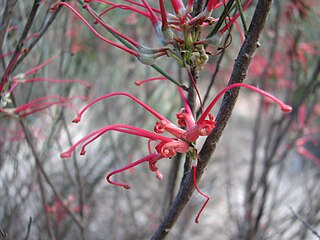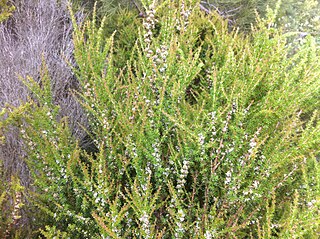
Agonis is a genus in the plant family Myrtaceae. All are endemic to Western Australia, growing near the coast in the south west.

Agonis flexuosa is a species of tree that grows in the south west of Western Australia. It is easily the most common of the Agonis species, and is one of the most recognisable trees of Western Australia, being commonly grown in parks and on road verges in Perth.

Banksia nobilis, commonly known as the golden dryandra, great dryandra or kerosene bush, is a shrub of the family Proteaceae which is endemic to Western Australia. It occurs on lateritic rises from Eneabba to Katanning in the state's Southwest Botanic Province. With large pinnatifid leaves with triangular lobes, and a golden or reddish pink inflorescence, it is a popular garden plant. It was known as Dryandra nobilis until 2007, when all Dryandra species were transferred to Banksia by Austin Mast and Kevin Thiele. There are two subspecies, B. nobilis subsp. nobilis and B. nobilis subsp. fragrans.

Taxandria juniperina commonly known as wattie, native cedar, Warren River cedar or juniper myrtle is a species of tree that grows in the south west corner of Western Australia. This plant was previously classified as Agonis juniperina but is now part of the genus Taxandria. The Noongar peoples know the tree as watti.

Taxandria is a group of plants in the family Myrtaceae described as a genus in 2007. The entire genus is endemic to Western Australia, growing near the coast in the South West corner of the State.

Gastrolobium lehmannii or Cranbrook Pea is a vulnerable shrub in the family Fabaceae which is endemic to an area of Western Australia.

Grevillea sarissa, the wheel grevillea, is a shrub which is native to South Australia and Western Australia. It grows to between 0.6 and 3.5 metres in height and produces yellow, red or pink flowers between August and December in its native range.

Taxandria marginata is a species of shrub that grows in the south west corner of Western Australia. This plant was previously classified as Agonis marginata but was reclassified by Wheeler and Marchant into the new genus Taxandria in a 2007 revision.

Kalmiopsis fragrans is a rare species of flowering plant in the heath family known by the common name North Umpqua kalmiopsis. It is endemic to Oregon in the United States, where there are just a few known populations, all within Douglas County.

Paragonis grandiflora is a plant species, endemic to the Southwest of Western Australia.

Petrophile longifolia, commonly known as the long-leaved cone bush is a shrub which is native to the south west of Western Australia, growing between the city of Albany and the Stirling Range.
Agonis baxteri is a shrub that is native to Western Australia.
Taxandria angustifolia is a species of tree that grows on the south coast of Western Australia. This plant was previously classified as Agonis angustifolia but is now part of the Taxandria genus.

Taxandria parviceps, commonly known as tea tree, is a shrub species that grows on the south west coast of Western Australia. This plant was previously classified as Agonis parviceps but is now part of the Taxandria genus.

Taxandria spathulata is a shrub species that grows along the southern coast of Western Australia. This plant was previously classified as Agonis spathulata but is now part of the Taxandria genus.

Taxandria linearifolia, also known as the swamp peppermint or the coarse teatree, is a small tree or shrub species that grows along south west coastal areas of Western Australia. This plant was previously classified as Agonis linearifolia but is now part of the Taxandria genus.
Taxandria floribunda is a small tree or shrub species that is endemic to an area in southern Western Australia. This plant was previously classified as Agonis floribunda but is now part of the Taxandria genus.
Taxandria callistachys is a shrub species that is endemic to an area in southern Western Australia.

Taxandria inundata is a species of shrub in the Myrtaceae family that is endemic to an area along the south western coast of Western Australia.
Judith Roderick Wheeler is an Australian herbarium botanist. After receiving an honours degree in botanical science, she was employed at the State Herbarium of South Australia, before moving to Western Australia's Murdoch University and later the West Australian Herbarium. Wheeler was the leading contributor to the two volume Flora of the South West (UWAP).













